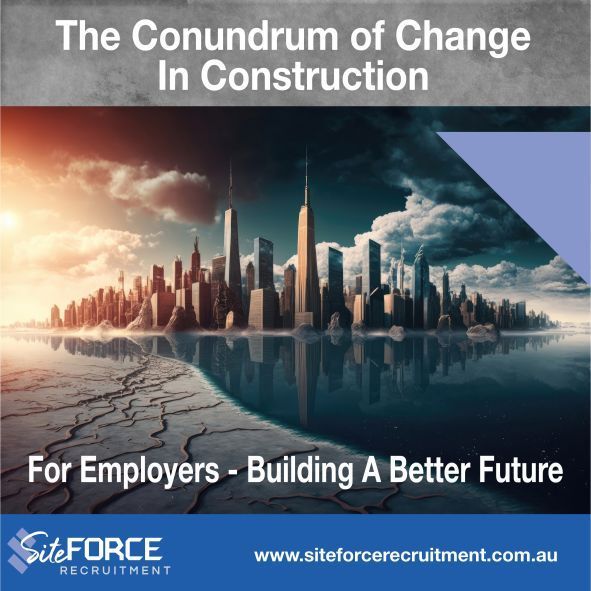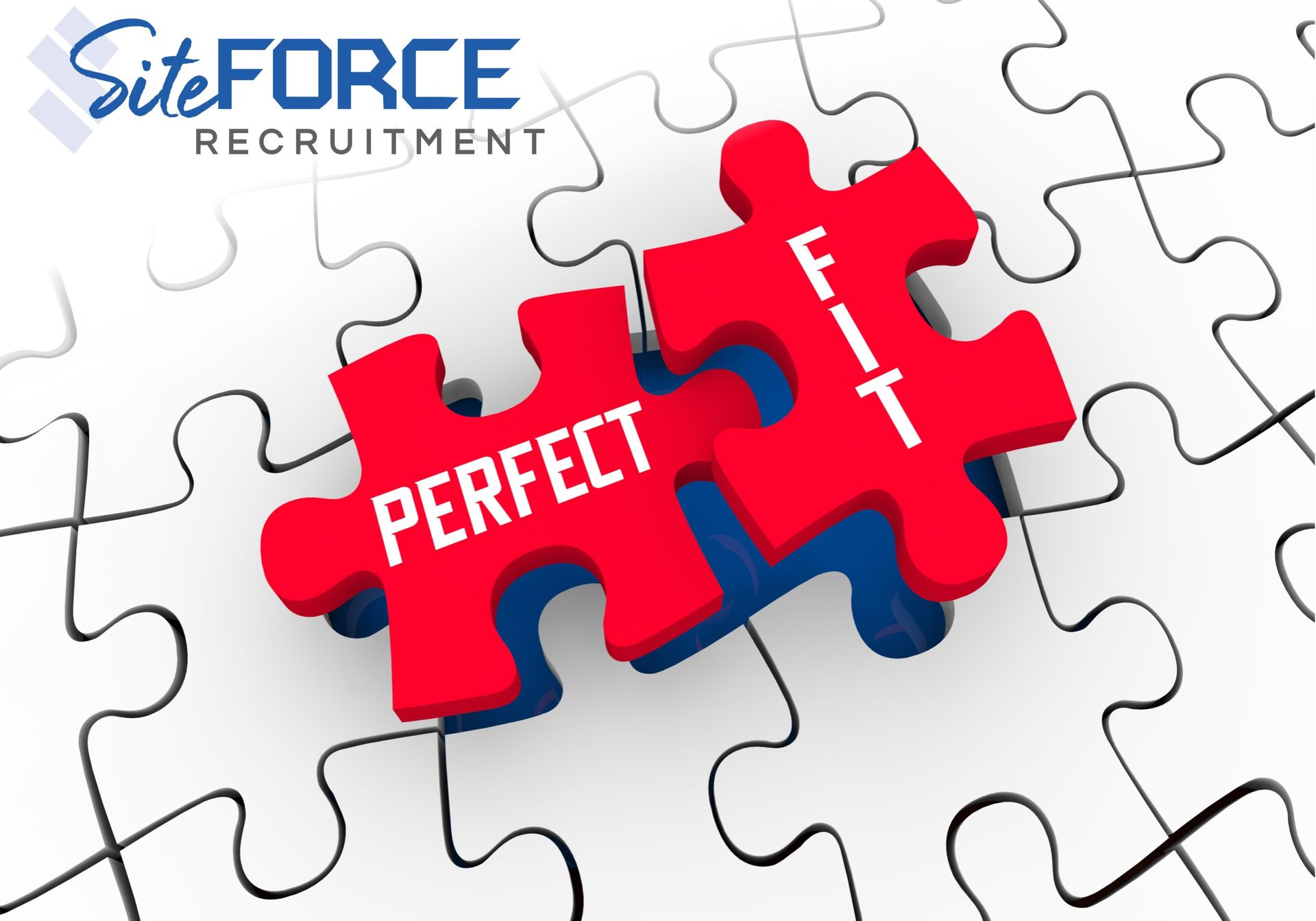The Conundrum of Change In Construction
For Employers - Building a Better Future

The construction industry in Australia has undergone a significant transformation in the past few years, with a shift towards sustainable construction, technology-driven practices and maintaining a productive and healthy workforce.
While these changes have brought several benefits to the industry, they have also led to an increased burden of legislation changes, supply chain issues, and the knock-on effects of Covid and significant bankruptcies in the industry.
These factors have resulted in significant challenges for employers in the construction industry in Australia, who must navigate these changes while dealing with the rate of change in employment, building legislation, employment legislation, and technology.
In this article, we will explore some of the key challenges facing the construction industry today and provide practical solutions to help navigate the conundrums of change. Whether you are a construction professional or simply interested in the industry, this article will provide valuable insights into the future of construction, how to stay ahead of the curve, and how we can help.
Industry Transformation in Australia
The Australian construction industry has undergone significant transformation in recent years. The shift towards sustainable construction practices has been a key driver of this transformation, with an increasing focus on reducing waste and energy consumption. The use of technology in construction has also been on the rise, with the adoption of Building Information Modelling (BIM) and other digital tools to improve productivity and reduce costs. Of course, as technology changes, so does the requirement for having a workforce up to date with training and industry needs.
Overall, Covid and its knock-on effects have forced the construction industry to adapt and innovate. As a result, there have been positive changes in the industry, which have improved safety, sustainability, efficiency, and collaboration, which has increased efficiency and reduced costs. Some positive changes in a challenging environment have been:-
· Collaboration and partnership: The construction industry has started to embrace collaboration and partnership with supporting industry professionals and other industries to achieve common goals. This has led to a better understanding of the role of construction in the overall economy, and has fostered innovative solutions to complex problems;
· Increased use of digital technology: The pandemic forced the construction industry to adopt new technologies to ensure work continued safely. Remote work, digital communication, and virtual meetings have become normal on in construction;
· Adoption of modular and prefabricated construction: The use of modular and prefabricated construction has increased since 2020. This approach allows for faster construction times, reduces waste, and increases quality control;
· Increased diversity and inclusivity: There is now a greater focus on diversity and inclusivity in the construction industry, which is improving working conditions and opportunities for marginalised groups. This is helping to build a more diverse and resilient workforce;
· Enhanced training and education: The need for skilled workers in the construction industry has led to increased training and education opportunities. This has helped to improve the quality of work, increase safety, and reduce the skills gap in the industry;
· Greater use of data: The use of data and analytics has become more prevalent in the construction industry. This has led to more informed decision-making, improved project planning, and greater efficiency;
· Greater emphasis on sustainability: The construction industry has become more aware of the need for sustainable building practices, which is driving innovation in sustainable building materials and techniques. This includes the use of renewable energy sources, green roofs, and passive design strategies;
· Focus on health and safety: The pandemic and legislative changes have put a spotlight on safety, which has led to increased safety protocols and procedures. This has resulted in a safer working environment for construction workers and an industry that is changing its focus on the mental health and wellness of its workforce.
The Burden on Employers: Procedures, Policies, People and Panic
Employers in the construction industry in Australia must navigate the rate of change in employment, building legislation, employment legislation, and technology. The industry's changing landscape requires employers to be proactive and adaptive to ensure they remain competitive and compliant with relevant laws and regulations.
Furthermore, the industry has experienced a series of high-profile bankruptcies in recent years, including those of several large construction companies. This has had significant implications for employees, subcontractors, and other stakeholders, leading to increased caution among employers.
Employers must ensure that they keep up with changes in employment laws, awards, working hours, superannuation and changing employee entitlements. Failure to comply with these laws can result in significant financial penalties, reputation damage, and legal action. We have seen some horror stories and heavy penalties issued by the ATO to others when it goes wrong.
Employers must also keep up with changes in building legislation, which can have significant implications for construction projects. Building regulations, codes, and standards are continually evolving, requiring employers to stay informed and adapt their practices accordingly.
Technology is also rapidly transforming the construction industry, with the adoption of BIM, drones, and other digital tools. It's also important to provide training and support to employees to help them adapt to the changes. This can help to reduce anxiety and fear and can increase buy-in from employees. Employers must invest in these technologies and ensure their workforce is trained to use them effectively.
Whilst we’ve seen a lot of positive changes, we’ve also seen a bit of panic with employers. So let’s see how SiteForce Recruitment can help.
Approaching Employing in the Construction Industry in 2023
Employers in the construction industry in Australia must adopt a proactive and strategic approach to employing in 2023. This includes developing a clear understanding of their workforce needs, identifying skills gaps, and investing in training and development programs.
Employers must also embrace diversity and inclusivity in their hiring practices, ensuring that they attract and retain talent from a range of backgrounds and experiences. This can help to address skills shortages and improve overall workforce productivity and engagement.
Another key consideration for employers is workplace health and safety. The construction industry is one of the most dangerous in Australia, with high rates of deadly incidents, making it the second most deadly industry after transport, postal and warehousing, indicating a significant increase in risks.
In addition to fatalities, the construction industry also has high rates of workplace injuries and illnesses. In 2020 there were over 15,000 serious workers compensation claims in the industry, accounting for 10% of all claims across all industries.
The human cost of workplace health and safety incidents cannot be overstated. Beyond the emotional impact on families and colleagues, work-related injuries and illnesses also have significant economic costs. According to Safe Work Australia, the direct and indirect costs of work-related injuries and illnesses in Australia are estimated to be $61.8 billion per year, of 4.1% of GDP.
When It Goes Wrong
According to a survey conducted by CareerBuilder, 75% of employers have hired the wrong person for a position. The survey also found that the cost of a bad hire can be significant, with 41% of employers estimating a single bad hire has cost them over $25,000, with 25% estimating a cost of over $50,000. When it goes wrong, it affects productivity, turnover rates, decreases morale and incurs additional financial costs associated with hiring and training a replacement.
According to a survey conducted by HireRight, 85% of employers caught applicants lying on their resumes or job applications. Common lies include exaggerating work experience, education or skills. However, it’s important to note that not all lies on job applications are intentional. Some may be due to misunderstandings or errors on the part of the applicant. It does however point out that the burden and risk can be huge.
What Needs to Change and Common Misconceptions about Change in the Construction Industry
Change is essential for any industry to grow and evolve, but many people in the construction industry are hesitant to embrace it. There are a few common misconceptions about change in the construction industry that prevent people from seeing its value. One of the most significant misconceptions is that change is too risky. Many people in the industry believe that if something has worked for them in the past, they should stick with it. However, this mindset can lead to missed opportunities and stagnation, particularly in the area of employment, where a fast and vast changing landscape for construction often requires a fast and vast deployment of staff.
Another common misconception is that change is too expensive. Many construction professionals believe that new technology, staffing, education and training and processes are too costly to implement, especially for smaller companies with limited budgets. However, the cost of not adapting to change can be even greater. Companies that fail to keep up with the latest trends risk falling behind their competitors and losing out on valuable windows of opportunities that are presenting themselves today.
Finally, some people in the industry believe that change is unnecessary. They may feel that the construction industry has worked the same way for centuries with traditional quoting, systems and staffing and that there is no need to change it now. However, the world is rapidly changing, and the construction industry must evolve to keep up with the times. Embracing change can lead to increased efficiency, sustainability, and profitability.
The Importance of Embracing Change
Now that we've dispelled some of the common misconceptions about change in the construction industry, let's explore why it's essential to embrace it. First and foremost, embracing change can lead to increased competitiveness.
Companies that are quick to adapt to new collaborations, technology and processes are more likely to win contracts and stay ahead of their competitors.
Embracing change can also lead to increased efficiency. New collaborations, technology and processes can streamline construction projects and reduce the time and resources required to complete them. This can lead to cost savings for the company and improved outcomes for clients.
Where to Now?
Overall, the key to managing the fast rate of change in the construction industry in Australia is to stay informed, be proactive, and embrace new technology, practices, procedures and collaborations. The construction industry in Australia can manage the fast rate of change in several ways, including:
1.
Collaboration and Outsourcing: Collaboration between stakeholders such as architects, contractors, and suppliers is essential to managing change effectively. Embracing an outsourcing model to industry experts for areas that are becoming more complex should be considered. Working together can ensure that everyone is on the same page, and that changes are communicated in a timely manner and effectively to decrease the burden and risk to the employer.
2.
Adapt to regulations: The construction industry in Australia is subject to a range of regulations, and companies must keep up to date with changes to these regulations. Staying informed and adapting to these changes can help construction companies manage the fast rate of change in the industry. Once again, outsourcing to industry specialists may be one solution.
3.
Embrace new technology: Construction companies should explore new technology and tools that can increase efficiency and reduce costs. This includes the use of Building Information Modeling (BIM), drones, virtual and augmented reality technology, robotics and automation, IoT technology (the internet of things) connecting various devices on construction sites allowing for real-time monitoring of equipment and site conditions, and artificial intelligence (AI) to analyse vast amounts of data, helping to identify patterns, optimise workflows and make more informed and timely decisions.
4.
Training and development: Keeping employees up to date with the latest technology and best practices is essential in managing change. Offering training and development opportunities can help employees adapt to change more easily.
5. Flexible project management: Adopting flexible project management approaches can help construction companies respond to changes more quickly and effectively. This approach prioritises adaptability, flexibility, communication, cost-effectiveness, stakeholder satisfaction, and innovation. It is a valuable approach for the construction industry in Australia, helping to ensure successful project outcomes in an ever-changing environment.
Outsourcing Recruitment and Labour Hire – How We Can Help
Outsourcing recruitment and labour hire can be a strategic move for the construction industry in Australia, as it can help businesses to save time and money, accessing a wider pool of talent and reduce the burden on employers. To find a full list of benefits, read our blog ‘How Much Time Do You Give Labour Hire To Settle Into A Site’ at: https://www.siteforcerecruitment.com.au/how-much-time-do-you-give-labour-hire-to-settle-into-a-site
With SiteForce Recruitment here are out steps that you can easily take to embrace outsourcing recruitment and labour hire, or simply call us to chat and we will help you with the process – it really is simple for us:-
·
Identify the business needs: The first step is to identify the specific areas where outsourcing recruitment and labour hire can benefit the business. This can involve assessing the current workforce, analysing the skill gaps, and determining the hiring needs.
·
Research outsourcing options: We will give you an overview of our services provided, the costs involved, and our track record.
·
Develop a clear strategy: We will walk you through developing a clear strategy for how outsourcing will be implemented. This can involve setting clear goals, defining roles and responsibilities, and outlining communication protocols.
· Build strong relationships: Building strong relationships is our speciality and is crucial for success. This involves regular, efficient and honest communication, providing feedback, and addressing any concerns or issues promptly.
· Monitor and evaluate performance: It's important to monitor and evaluate the performance of the teams regularly. This can involve tracking metrics such as time-to-hire, quality of hires, and cost savings. Any issues or areas for improvement are welcome, implemented and always addressed promptly.
By following these steps, the construction industry in Australia can embrace outsourcing recruitment and labour hire in a strategic and effective manner, which can help businesses to stay competitive and achieve their goals. Of course, the first step is to call us and put that collaborative plan into action.
Related articles:
Workforce Fluctuations, Flu and Finalising Projects
SiteForce Recruitment specialise in labour-hire and permanent recruitment in the construction industry. We are committed to valuing people, safety and well-being, collaboration, trust and of course – results!
CONNECT with us via our contact page or bookings links on our website if you are looking to recruit for, get your dream job, or join our amazing labour force team.
#siteforcerecruitment #recruitment #labourhire #brisbanejobs











